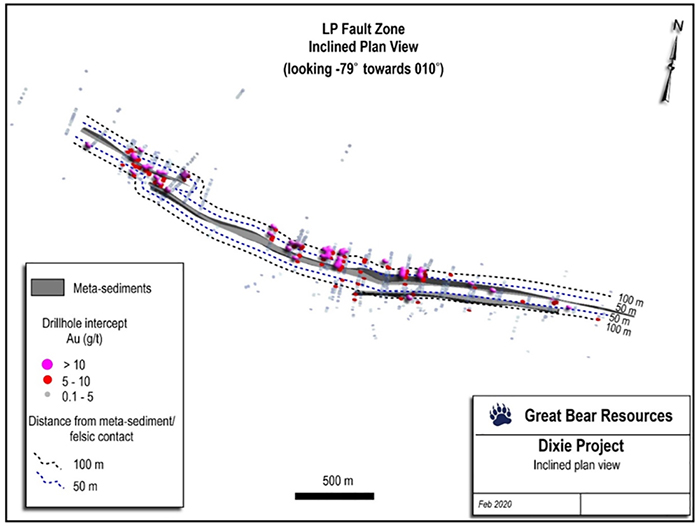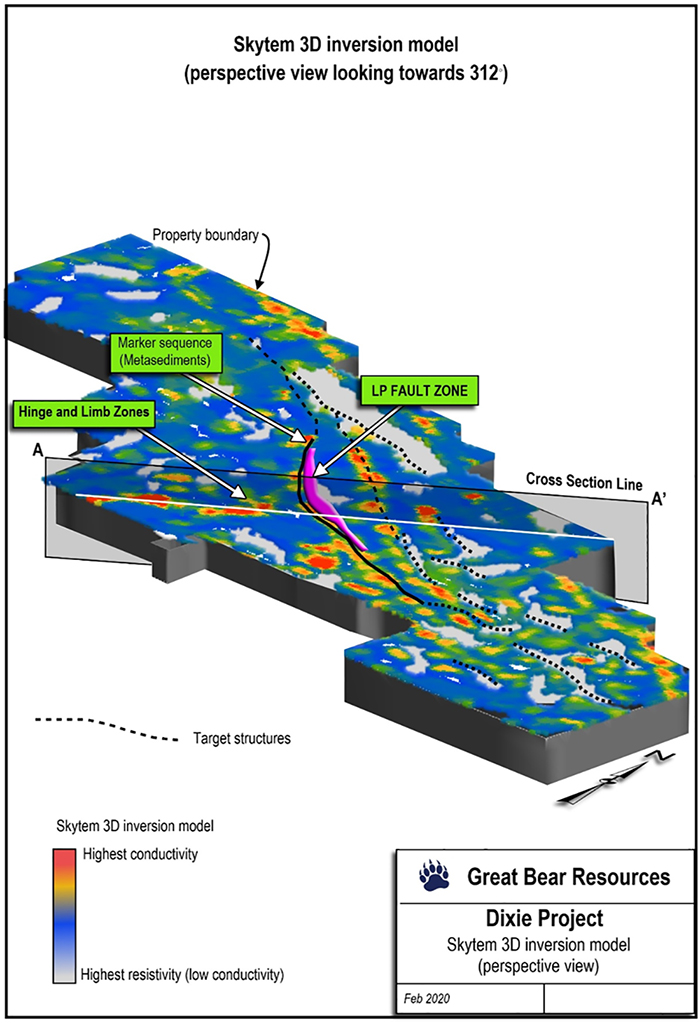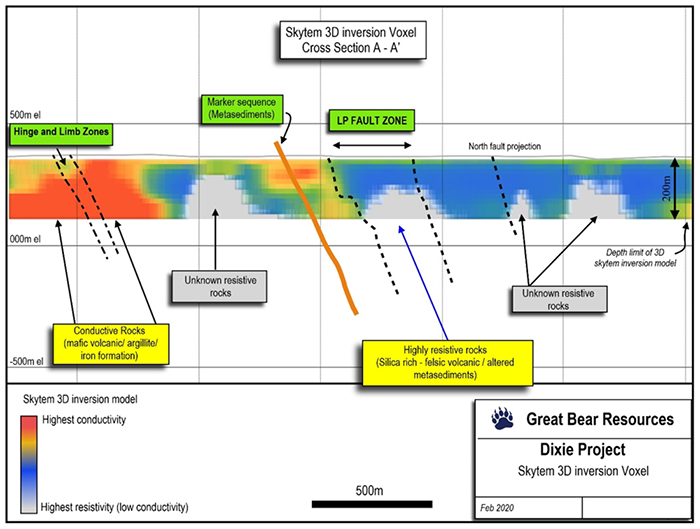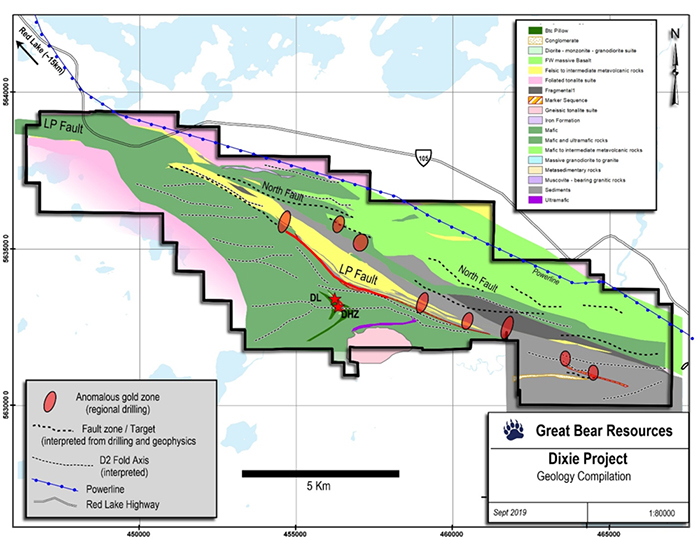Great Bear Defines High-Grade Gold Controls at LP Fault; Regional Drilling Identifies Six New Gold Targets Over 11 Kilometres; Provides LP Fault Drill Data
February 20, 2020 – Vancouver, British Columbia, Canada – Great Bear Resources Ltd. (the "Company" or "Great Bear", TSX-V: GBR) today reported new developments from its fully funded $21 million exploration program at its 100% owned flagship Dixie Project in the Red Lake district of Ontario.
The Company has made significant progress in its predictive modeling of gold mineralization at the LP Fault zone, and its regional exploration program. Highlights include:
- Identification of key geological controls to the distribution of high-grade gold mineralization along the LP Fault. High-grade gold mineralization occurs in close proximity to a steeply-dipping felsic volcanic/metasedimentary contact. Figure 1.
- The Company has retained Mr. James Gray, P.Geo., an independent consultant from Advantage Geoservices Ltd., to assist Great Bear’s geological team with gold mineralization modeling. Mr. Gray’s experience includes resource definition drilling and geological modeling at the David Bell mine at the Hemlo gold deposit, formerly operated by Teck Corporation, and currently owned by Barrick Gold Corp.
- An airborne SkyTEM (electromagnetic) survey has been completed across the property, identifying new regional exploration drill targets. The new targets have similar geophysical characteristics to both the LP Fault zone and the Hinge and Dixie Limb zones. Follow-up drilling is required. Figure 2 and Figure 3.
- 13 reconnaissance drill holes were completed outside of previously drilled areas across 11 kilometres of the property. The primary purpose of this drilling was to identify favorable structural and geological settings for additional follow-up drilling. Six new occurrences of highly anomalous gold mineralization have been discovered in 9 of the 13 drill holes, as shown on Figure 4. Highlighted results are included in the drill results table posted to the Company’s website at www.greatbearresources.ca.
- These new gold occurrences include: 1) highly deformed metasedimentary rocks (LP Fault style), and 2) quartz vein systems (Hinge zone style). The geological marker sequence (deformed meta-sedimentary rocks) previously identified at the LP Fault zone has now been intersected along approximately 7 kilometres. Drill density is insufficient at this time to determine what the gold distributions and geometries of these new gold occurrences may ultimately be. Follow-up drilling is required.
- The Company has engaged consultants to assist with preliminary metallurgical testing of gold mineralized samples in advance of more advanced studies planned for 2021.
- Ongoing environmental baseline studies continue on the property.
- As previously announced on February 13, 2020, a table of highlighted assay results, including drill locations, azimuths and dips from the central 4.2 kilometre segment of the LP Fault have now been posted to the Company’s web site. The Company has also provided three dimensional .DXF files of important geological controls on mineralization.
Chris Taylor, President and CEO of Great Bear said, “Ongoing drilling has shown us that the gold-mineralized system at Dixie is at least 11 kilometres in strike extent. These early reconnaissance drill results are very similar to our initial footwall drilling into the LP Fault zone in 2018 and early 2019. We now need to drill in the vicinity of these new occurrences to determine if and where high-grade gold is present, and whether these occurrences are connected. Within the LP Fault zone itself, high-grade gold adjacent to a felsic volcanic/metasediment contact marks an additional similarity to Barrick’s Hemlo deposit. The gold deposits at Hemlo display similar geological and structural contexts, and have similar disseminated high-grade gold mineralization as observed at the LP Fault.”
Figure 1: Distribution of gold intercepts and distance buffers of 50 and 100 metres from the contact between metasediments and felsic volcanic rocks along 4.2 kilometres of the LP Fault.
Newly Identified Gold Controls
Ongoing LP Fault drilling has demonstrated that most of the > 5 g/t gold intercepts and nearly all of the >10 g/t gold intercepts drilled along the LP Fault to-date occur within 50 to 100 metres of the metasedimentary/felsic volcanic contact.
This gold mineralization control provides a laterally and vertically-extensive, sheet-like contact that can be targeted with ongoing drilling, and will be important to ongoing modeling of the LP Fault zone.
Regional Geophysics and Reconnaissance Drilling
The Company completed a high-resolution electromagnetic (SkyTEM) airborne geophysical survey over the entire Dixie property in September of 2019 and recently received the survey results. The purpose of the survey was to test if the LP Fault style of mineralization produces a resistive electromagnetic response. The LP Fault mineralization is associated with strong silica and albite alteration of felsic volcanic and metasedimentary rocks, which was expected to be electrically resistive. Results confirmed highly resistive responses below the known sections of the LP Fault in the modelled 3D inversion of the SkyTEM data (Figures 2 and 3), and several new multi-kilometre resistive trends with similar geophysical properties to the gold zone of the LP Fault have been identified and warrant follow-up field work and ultimately drill testing.
The Company also repeated its exploration methods from the initial LP Fault discovery with additional regional drilling. High-contrast magnetic breaks were drilled prior to receipt of the SKYTEM data, on one to two kilometre centres along the projected strike extent of the LP Fault, and targeting additional regional features. The purpose of this program was to identify similar structural and geological settings to the LP Fault mineralization. Multiple zones of anomalous gold were intersected along an interpreted strike length of 11 kilometres. Some of these new zones display similarities to the LP Fault Zone and others are more comparable to the Hinge zone vein system.
Highlights of regional reconnaissance drill holes have been included in the LP Fault results table posted to the Company’s web site. Drill holes that successfully intercepted gold mineralization were: BR-052, 053, 054, 055, 056, 071, 072, 073, and 111. Seven of the nine drill holes which successfully intercepted gold mineralization are located along a possible on-strike projection of the LP Fault zone, while 2 of the gold-bearing drill holes occur at new regional targets (Figure 4). Reconnaissance drill holes that did not intersect gold were BR-048, 049, 070 and 110.
Live Webinar on Thursday February 20th
Great Bear reminds interested shareholders that they are invited to join a webinar detailing recent progress in the Company’s ongoing fully-funded 200,000 metre drill program on Thursday, February 20th at 11:15am PST/2:15pm EST. Management will be available to answer questions following the presentation. Online registration and participation details may be found at the following link:
For those unable to participate, a recording of the webinar will be posted to the Company’s web site following the live broadcast.
Figure 2: SkyTEM results showing interpreted resistivity targets along the Dixie property, including the LP Fault. Resistive rocks including the altered/mineralized zone of the LP Fault are shown in blue and white. Locations of newly drilled regional gold zones are shown below in Figure 4.
Figure 3: Resistivity/chargeability cross section of SkyTEM data showing the LP Fault zone, with adjacent high-resistivity targets also shown (blue to white targets).
ABOUT THE DIXIE PROJECT
The Dixie Project is 100% owned, comprised of 9,140 hectares of contiguous claims that extend over 22 kilometres, and is located approximately 25 kilometres southeast of the town of Red Lake, Ontario. The project is accessible year-round via a 15 minute drive on a paved highway which runs the length of the northern claim boundary and a network of well-maintained logging roads.
The Dixie Project hosts two principle styles of gold mineralization:
- High-grade gold in quartz veins and silica-sulphide replacement zones (Dixie Limb and Hinge). Hosted by mafic volcanic rocks, and localized near regional-scale D2 fold axes. These mineralization styles are also typical of the significant mined deposits of the Red Lake district.
- High-grade disseminated gold with broad moderate to lower grade envelopes (LP Fault). The LP Fault is a significant gold-hosting structure which has been seismically imaged to extend to 14 kilometres depth (Zeng and Calvert, 2006), and has been interpreted by Great Bear to have up to 18 kilometres of strike length on the Dixie property. High-grade gold mineralization is controlled by structural and geological contacts, and moderate to lower-grade disseminated gold surrounds and flanks the high-grade intervals. The dominant gold-hosting stratigraphy consists of felsic sediments and volcanic units.
Figure 1: Map of recent regional reconnaissance drilling showing areas with confirmed gold-bearing drill intercepts.
About Great Bear
Great Bear Resources Ltd. is a well-financed gold exploration company managed by a team with a track record of success in mineral exploration. Great Bear is focused in the prolific Red Lake gold district in northwest Ontario, where the company controls over 300 km2 of highly prospective tenure across 4 projects: the flagship Dixie Project (100% owned), the Pakwash Property (earning a 100% interest), the Dedee Property (earning a 100% interest), and the Sobel Property (earning a 100% interest), all of which are accessible year-round through existing roads.
QA/QC and Core Sampling Protocols
Drill core is logged and sampled in a secure core storage facility located in Red Lake Ontario. Core samples from the program are cut in half, using a diamond cutting saw, and are sent to Activation Laboratories in Ontario, an accredited mineral analysis laboratory, for analysis. All samples are analyzed for gold using standard Fire Assay-AA techniques. Samples returning over 10.0 g/t gold are analyzed utilizing standard Fire Assay-Gravimetric methods. Pulps from approximately 5% of the gold mineralized samples are submitted for check analysis to a second lab. Selected samples are also chosen for duplicate assay from the coarse reject of the original sample. Selected samples with visible gold are also analyzed with a standard 1 kg metallic screen fire assay. Certified gold reference standards, blanks and field duplicates are routinely inserted into the sample stream, as part of Great Bear’s quality control/quality assurance program (QAQC). No QAQC issues were noted with the results reported herein. Drill hole location information is provided below:
Qualified Person and NI 43-101 Disclosure
Mr. R. Bob Singh, P.Geo, Director and VP Exploration, and Ms. Andrea Diakow P.Geo, Exploration Manager for Great Bear are the Qualified Persons as defined by National Instrument 43-101 responsible for the accuracy of technical information contained in this news release.
ON BEHALF OF THE BOARD
“Chris Taylor”
Chris Taylor, President and CEO
Investor Inquiries:
Mr. Knox Henderson
Tel: 604-551-2360
Fax: 604-646-4526
info@greatbearresources.ca
www.greatbearresources.ca
Cautionary note regarding forward-looking statements
This release contains certain “forward looking statements” and certain “forward-looking information” as defined under applicable Canadian and U.S. securities laws. Forward-looking statements and information can generally be identified by the use of forward-looking terminology such as “may”, “will”, “should”, “expect”, “intend”, “estimate”, “anticipate”, “believe”, “continue”, “plans” or similar terminology. The forward-looking information contained herein is provided for the purpose of assisting readers in understanding management’s current expectations and plans relating to the future. Readers are cautioned that such information may not be appropriate for other purposes.
Forward-looking information are based on management of the parties’ reasonable assumptions, estimates, expectations, analyses and opinions, which are based on such management’s experience and perception of trends, current conditions and expected developments, and other factors that management believes are relevant and reasonable in the circumstances, but which may prove to be incorrect.
Great Bear undertakes no obligation to update forward-looking information except as required by applicable law. Such forward-looking information represents management's best judgment based on information currently available. No forward-looking statement can be guaranteed, and actual future results may vary materially. Accordingly, readers are advised not to place undue reliance on forward-looking statements or information.





